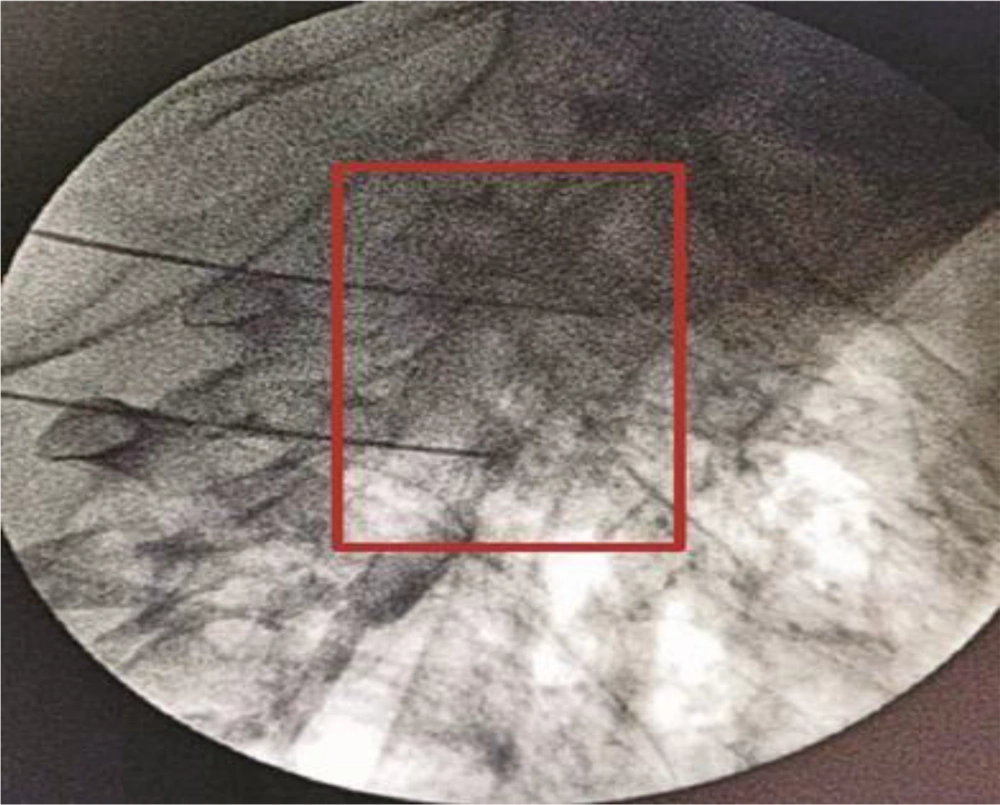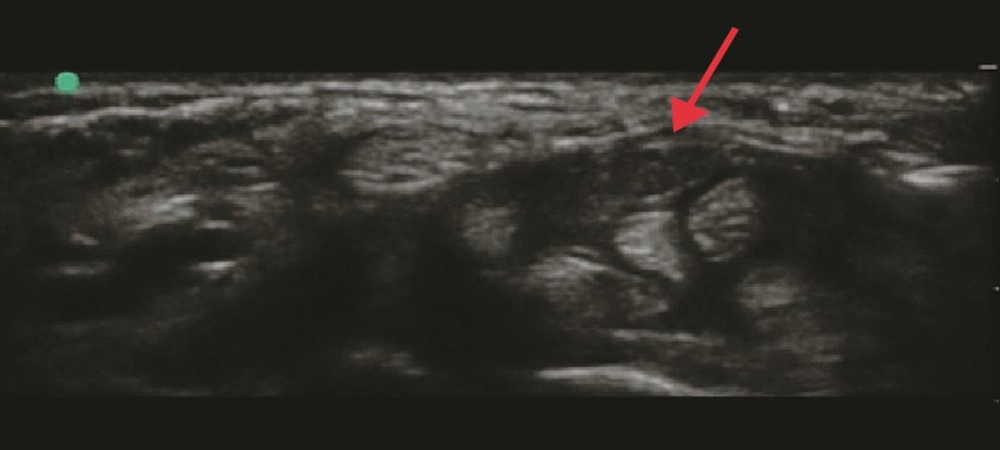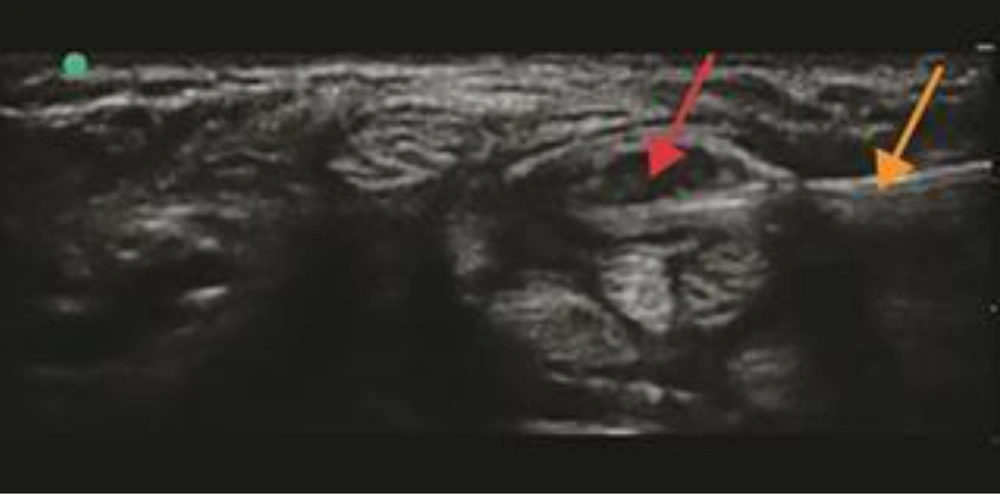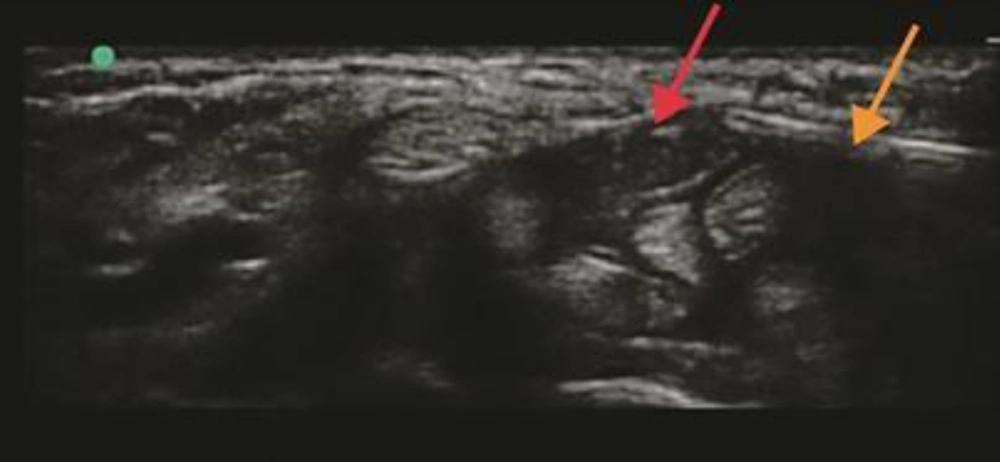1. Introduction
Hyperhidrosis is the maladjustment characterized by over sweating in the particular parts of the human body comprising numerous eccrine glands, such as hands and soles (1, 2). Annually, about 1% - 4.4% of the US population (nearly 7.8 million individuals) develop hyperhidrosis (3-5). Hyperhidrosis creates serious problems causing discomforts in psychosocial aspects and daily functions. In addition, hyperhidrosis is associated with an enhanced risk of skin disorders (2-6). Curative strategies of hyperhidrosis can be separated into two groups, namely surgical and non-surgical. The non-surgical strategies include systemic and topical interventions, such as the injection of botulinum toxin. However, each strategy has its own limitations (7-9).
Surgical interventions are developed for patients with conditions requiring sympathectomy (10). It is worth noting that surgery has several limitations, such as general anesthesia. Furthermore, it may cause considerable intraoperative problems, post-surgical hematoma, swelling, and pain (11, 12). Radiofrequency (RF) therapy is a less invasive technique containing the utilization of electromagnetic energy that is deposited near the nerve tissue. In addition, RF has a low cost and can be performed in outpatient centers (13).
The mechanism of action of continuous RF could be explained by the destruction of afferent nerve fibers on their way from a nociceptive focus to the central nervous system. Pulsed radiofrequency (PRF) was invented to explore this possibility, with the sole purpose of finding a less destructive and equally effective technique for the application of RF to afferent pathways (14). Moreover, PRF has a new role in the inhibition of oxidative stress and restoration of antioxidant enzymes to control levels and may block the production of inflammatory markers in the muscles of animals subjected to trauma (15).
The RF therapy can be applied to relieve different chronic pain syndromes, such as post-amputation phantom limb pain, radicular pain in lumbar herniated disc prolapse, occipital neuralgia, and cluster headache (16-20), some of which described lumbar and thoracic sympatholysis (21). Herein, we report the case of a male patient with an age of 22 years undergoing thermal RF sympathectomy therapy for palmar hyperhidrosis of his right hand. However, no study has investigated the new complications, such as severe spasms, severe pain, and congestion, appearing with RF therapy for the treatment of palmar hyperhidrosis.
2. Case Presentation
Informed consent was obtained from a male worker patient with an age of 22 years. Laboratory values, including prothrombin time, platelet count, international normalized ratio, complete blood count, thyroid hormone levels (i.e., triiodothyronine, thyroxine, and thyroid-stimulating hormone), serum sodium, potassium, and calcium levels, and renal and liver function tests were normal, which excluded other causes of excessive sweating and coagulopathy. Thermal RF ablation for severe palmar hyperhidrosis of the right hand was carried out at Fayoum University Hospital in Egypt on 20 October 2020.
The patient was regularly followed up after the procedure weekly for the first month and then monthly for 2 months for a total follow-up period of 3 months by an anesthesiology resident. The patient did not receive any medical treatment, and there were no other concomitant medical conditions requiring attention. The case had no history of other surgeries or interventions related to hyperhidrosis or unrelated indications. The RF ablation was performed on the right hand. The patient was known to have bilateral hyperhidrosis; therefore, we conducted the RF ablation in a sequenced method to avert bilateral pneumothorax.
Briefly, the patient was evaluated and serened. Then, before draping and placing, the patient was placed in the prone position. Standard monitoring of non-invasive blood pressure (NIBP) and pulse oximetry was applied for the patient to record heart rate, NIBP, and oxygen saturation. Intravenous (IV) access was performed, and sedation was given to the patient in the form of IV 2 mg midazolam plus IV 4 mg nalbuphine. The patient was submitted to diagnostic right thoracic sympathetic block at T2 and T3 level with 5 mL of 1% lidocaine in each cannula with excellent subjective results by the patient regarding the increased temperature of his right hand before proceeding to the RF procedure.
In our anesthesiology and pain medicine department, the usual method for using RF therapy is defined as the application of a Neurotherm NT 2000 Lesion Generator (the USA manufactured) after performing subcutaneous local anesthetic infiltration to conduct RF thermal ablation. Under fluoroscopic guidance, the fluoroscopy was adjusted to be in the anteroposterior view and then directed to be 15 degrees in the cephalad direction and 15 degrees in the right lateral position. Two 10-cm-length 18-gauge disposable RF needles with 5-mm active tip connected to the RF device were advanced to the T2 and T3 sympathetic ganglion up to the middle of thoracic vertebrae. The omnipaque dye injection was approved after hitting the target with the needle (Figures 1 and 2). After positioning the electrode of the RF device on the cannula, the measured impedance ranged from 200 Ω to 400 Ω.
Paresthesia was measured by a 50-Hz sensory stimulation at 0.3 V - 0.5 V to confirm the cannula position. Using a 2-Hz motor stimulation at 1.3 V - 1.5 V revealed no motor contraction. Following the neurophysiologist examination, RF thermal coagulation was used in two intervals at 90°C for 90 sec. After thermal coagulation, 2 mL of 2% lidocaine was used through the cannula. The patient experienced an increase in temperature of his right hand, and congestion of the right hand was observed. The patient was examined for any problem during the next 12 h following the intervention. The patient was discharged on the day of providing the intervention.
The primary outcome was the presence/absence of hyperhidrosis. In this case study, the Hyperhidrosis Disease Severity scale was used, involving asking the patient to describe his sweating status before and after the operation. A score of 1 or 2 was classified as mild or moderate hyperhidrosis, and a score of 3 or 4 was classified as severe hyperhidrosis. A 1-point decrease in the patient’s sweating scale means a 50% decrease in sweat production, and a 2-point decrease means an 80% decrease in sweat production (11).
The secondary outcomes included compensatory hyperhidrosis events, classified as no compensatory hyperhidrosis, mild (i.e., sometimes sweaty and sometimes not sweaty), moderate (i.e., constantly aware but not troublesome or troublesome but controlled by clothing), and severe (i.e., causing embarrassment or regret over having undergone endoscopic thoracic sympathectomy) (22). Other secondary outcomes included patient satisfaction (satisfied or not satisfied), preoperative, intraoperative, and postoperative evaluation of measured hemodynamic parameters, and other complications (i.e., pneumothorax, hematoma, ptosis, muscle weakness, and muscle spasm).
3. Discussion
The RF ablation has a success rate of 85% - 95% in the treatment of hyperhidrosis in the right hand; nevertheless, this was observed to be less than or equal to the success rate of surgery in previous studies evaluating RF ablation for hyperhidrosis. In the present case report, compensatory hyperhidrosis was absent. In addition, a dry right hand was achieved after the procedure resulting in a decrease in hyperhidrosis by 25% on the left hand without any need for intervention in this hand, indicating that the symptoms of the left hand had downgraded from severe to moderate hyperhidrosis. There were no other complications, including pneumothorax, hematoma, infection, muscle weakness in the right hand, hemodynamic changes, and ptosis.
Patient satisfaction was 85%, except for one complication occurring during follow-up on the 17th day after the intervention, in which we observed muscle spasm in the flexor of the right hand. This spasm was defined as a compensatory muscle spasm of the flexor of the hand, which was associated with severe pain and congestion of the right hand. This spasm in the flexor muscle of the right hand, severe pain, and congestion were gradually relieved after two sonar-guided median nerve blocks achieved by the injection of 2 mL lidocaine 2% plus 2 mL dexamethasone at 3-day intervals between each block. There were no changes in the outcome measured during the 3-month follow-up period.
The nerves located in the sympathetic chain in the thoracic area regulate sweating in the hands. Therefore, their destruction often inhibits the hyperhidrosis of the hands. According to the literature, the operation is successful in about 90% - 97% of cases. However, the success rate in RF ablation in previous studies was reported to be approximately 75% (12-23); nonetheless, the success rate of 85% - 95% was observed in the present case report. Nevertheless, surgical intervention is not usually performed as it is invasive, and general anesthesia is necessary and is associated with considerable pain in the postoperative period.
Surgical intervention is the last procedure in hyperhidrosis treatment. In addition, this procedure is safe and effective. It seems that this case report has been the first attempt to describe the effects of an RF ablation intervention in palmar hyperhidrosis, with a significant success rate range of 85% - 95%. Conversely, the success rate of surgical intervention (90% - 97%) is higher (12-23), which can be attributed to the complexity of the RF ablation procedure. Moreover, the fact that the interventional pain physician did not have enough experience in eliciting this block may have an important role in this difference.
Sympathectomy has several negative consequences, including compensatory hyperhidrosis (24, 25). Some studies reported that compensatory hyperhidrosis is a major factor in measuring the satisfaction of individuals with the provided intervention. According to previous studies, the incidence of compensatory hyperhidrosis is estimated at 60% - 90% (25, 26). In the present case report, compensatory hyperhidrosis was absent, which is in contrast to the results of previous reports (26, 27). Patient satisfaction in this case report was about 85%; nonetheless, satisfaction in previous studies was 73% in RF-treated patients and 83% following the surgical intervention (22).
No other complications were observed in this patient, such as pneumothorax, ptosis, hematoma, infection, or muscle weakness, in the right hand. On the 17th day after the intervention, muscle spasms were observed in the flexor of the right hand. Severe pain and congestion in the right hand during heavy working may be due to aberrant sympathetic nervous system functioning of the right hand subjected to the intervention.
This report has described such aberrant sympathetic dysfunction for the first time; however, previous studies have demonstrated that aberrant sympathetic dysfunction may appear as compensatory hyperhidrosis and pain. A possible explanation may be attributed to the fact that sympathetic nervous system ablation leads to changes in neuromuscular junction transmission and muscle power generation capacity, ultimately leading to the dysregulation of skeletal muscle innervation and an impact on function (28).
Another mechanism that may be responsible for this spasm with congestion and severe pain in the flexor muscle of the right hand during heavy work may be related to sympathetic innervation to the small arteries and arterioles, which is also responsible for neuromuscular transmission without sympathetic supply to veins and venules in normal individuals. Consequently, the functional sympathectomy normally occurring during exercise increases the blood supply to muscles, and reflex sympathetic vasoconstriction happens to control blood flow to the contracted muscle, which is responsible for the muscle fatigue observed afterward. Although, in a previous study where adrenergic receptor antagonist drugs were used (drug-induced sympatholysis), the absence of sympathetic vasoconstriction led to a reduction in muscle fatigue during the tetanic contraction of the muscle.
The above-mentioned mechanisms may explain the severe spasm, pain, and congestion of the flexor muscle of the right hand after sympathetic ablation by thermal RF ablation (29). In this patient, we defined this spasm as a compensatory muscle spasm of the flexor of the hand, which has not been described in previous studies. This spasm in the flexor muscle of the right hand was gradually relieved after two sonar-guided median nerve block interventions using two successive injections with 2 mL lidocaine 2% plus 2 mL dexamethasone at 3-day intervals between each block at the level of the wrist, with no resultant residual muscle weakness or loss of sensation of the right hand (Figures 3-5).
3.1. Limitations and Conclusions
This study has been the first clinical case report complicated by the development of a contraction of the flexor muscles of the right hand with severe pain and congestion after heavy work on the 17th day after the intervention. No other complications were observed. The spasm was gradually relieved by sonar-guided median nerve injection at the wrist with no residual muscle weakness or loss of sensation of the right hand and intended to assess the role of RF ablation with the success rate of 85-95% in palmar hyperhidrosis. This study has the limitations of any other case report. It would be necessary to perform a case series study to draw better conclusions. Another limitation was the 3-month short follow-up period.




